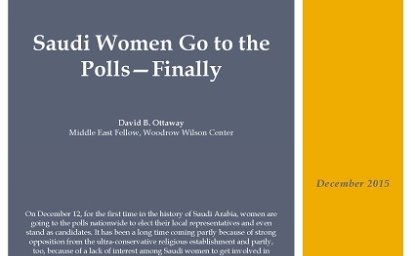Saudi Women Made History–But Still Have a Long Way to Go
"Women’s participation in this weekend’s elections is an important step in the struggle for women’s rights in Saudi Arabia, but formidable obstacles remain," writes Haleh Esfandiari.
"Women’s participation in this weekend’s elections is an important step in the struggle for women’s rights in Saudi Arabia, but formidable obstacles remain," writes Haleh Esfandiari.
A taboo was broken in Saudi Arabia this weekend when women voted for the first time. At least 17 women were elected in Saturday’s municipal council elections, a state-run news site reported Sunday.
More than 900 women registered as candidates, and about 130,000 women registered to vote, compared with 1.36 million men. During the campaign female candidates were allowed to speak only to female audiences. It was left to men to represent female candidates before male voters, and candidates were not allowed to use their pictures in their campaign materials. King Abdullah promised in 2011 to extend to women the right to vote and stand as candidates in municipal elections–the local councils are the only popularly elected bodies in Saudi Arabia’s monarchy–and his successor, King Salman, made good on the pledge. It was another major advance when King Abdullah appointed 30 women to the Consultative Assembly, known as Majlis al-Shura, in 2013. The council serves as an advisory body to the king; it can propose laws but not enact or enforce them.
Women’s participation in this weekend’s elections is an important step in the struggle for women’s rights in Saudi Arabia, but formidable obstacles remain. Just before King Abdullah’s announcement regarding women and municipal elections, Saudi Arabia’s highest religious authority, its grand mufti, deemed women’s involvement in politics as “opening the door to evil.” It remains to be seen whether male-female segregation will prevail in the councils, which have limited say in local government; in the Shura, men and women go into the building through separate entrances and sit separately.
For women, the progressiveness of Saudi society remains strictly limited. Women do not have the right to seek a divorce. Polygamy is legal; in divorces, custody of children is invariably granted to the father. There is no minimum age of marriage for girls. Women need the permission of a spouse, their father, or a male guardian to work or to apply for a passport; when a passport is granted, a woman’s male guardian is the one to pick it up. Until a few years ago, women could not have identity cards. A recent law allows widowed and divorced Saudi women to get a family identity card that allows a mother to register her children in school or permit medical procedures without a male guardian’s permission.
When it comes to women’s rights, Saudi Arabia lags well behind other Arab countries in the Middle East and North Africa, including the kingdom’s conservative neighbors in the Persian Gulf. In many of these countries, women are members of parliament, Cabinet ministers, and ambassadors. Women can drive cars and dress as they like. The contrast to Saudi Arabia is striking.
Granted, Saudi Arabia has taken some long overdue steps. But the kingdom still has a long way to go before women achieve a minimum of rights.
The opinions expressed here are solely those of the author.
This article was originally published in The Wall Street Journal's Think Tank blog.


The Wilson Center’s Middle East Program serves as a crucial resource for the policymaking community and beyond, providing analyses and research that helps inform US foreign policymaking, stimulates public debate, and expands knowledge about issues in the wider Middle East and North Africa (MENA) region. Read more



